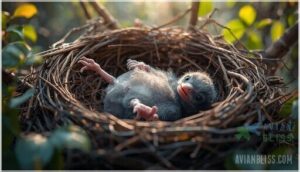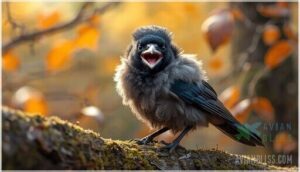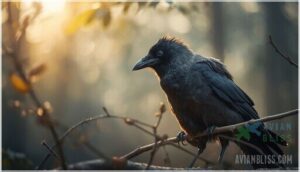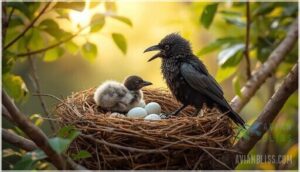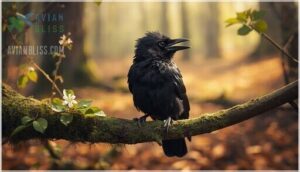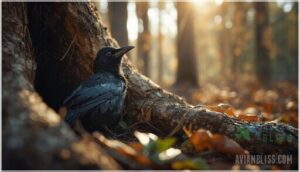This site is supported by our readers. We may earn a commission, at no cost to you, if you purchase through links.

You’ll spot baby crows by their bright blue eyes, pink mouth gapes, and high-pitched begging calls that sound nothing like the harsh caws of adults. Understanding what baby crows look like and how they behave helps you know when they need help and when they’re simply learning to navigate the world under watchful parental supervision.
Table Of Contents
- Key Takeaways
- Baby Crow Appearance
- Baby Crow Size and Weight
- Baby Crow Behavior and Development
- Baby Crow Diet and Feeding
- Finding and Caring for Baby Crows
- Baby Crow Safety and Protection
- Baby Crow Life Cycle
- Baby Crow Identification
- Baby Crow Parenting and Social Structure
- Frequently Asked Questions (FAQs)
- Why don’t we see baby crows?
- How to identify a baby crow?
- What do you do if you find a baby crow?
- How long do baby crows stay in the nest?
- What time of year do crows leave nests?
- How long before a baby crow can fly?
- What to do if baby crow is injured?
- Do parent crows abandon fledglings?
- How to identify a baby crow visually?
- What sounds do baby crows make?
- Conclusion
Key Takeaways
- Baby crows go through rapid transformation in just four weeks, developing from naked, blue-eyed hatchlings weighing 30 grams into fully feathered fledglings that remain dependent on family groups for months while learning essential survival skills through observation and practice.
- Most grounded baby crows don’t need rescuing—fledglings naturally spend 1-2 weeks hopping awkwardly on the ground while parents continue feeding and protecting them, so intervention is only necessary when you observe visible injuries, bleeding, or complete absence of parents after 2-4 hours.
- Crow families operate through cooperative breeding systems where older siblings often help feed and protect nestlings, with this extended family structure boosting survival rates by up to 30% and providing juveniles with critical social learning that increases problem-solving abilities by 37%.
- You can identify baby crows by their bright blue eyes (which turn brown with age), pink gape and beak (darkening to black), scruffy grayish-black plumage, and high-pitched begging calls that sound completely different from adult caws.
Baby Crow Appearance
Baby crows look quite different from their sleek, all-black parents when they first hatch. You’ll notice several distinctive features that change as they grow from helpless chicks into young fledglings.
Let’s look at what sets baby crows apart at each stage of their early development.
Baby Crow Physical Characteristics
When baby crows emerge, they’re featherless hatchlings with pinkish skin and striking blue eyes that gradually shift to brown within their first few weeks. Their beaks start pale pink and stubby, darkening to black as they mature. Feather development kicks in within two days, with soft, fluffy down replacing bare skin.
You’ll notice their legs appear greyish before turning black, and their proportionally large heads and eyes give them that classic baby bird look before they reach full size. These nests are often built with dead twigs.
Development Stages of Baby Crows
From hatchling to independent bird, baby crow development unfolds in three distinct stages. Nestlings spend their first 7-10 days naked and helpless, eyes shut tight, needing constant warmth. By week two, pin feathers emerge and eyes open, revealing those signature blue irises.
At 4-5 weeks, they become fledglings—fully feathered but wobbly fliers who hop around on the ground while perfecting their wings. Juveniles stick with their family for months, sometimes years, mastering foraging and social skills through observation. It’s important to note that baby crows have bright blue eyes and pink bills.
This fledgling timeline varies slightly, but parental support remains constant throughout each independence shift.
Distinguishing Features of Baby Crows
You’ll notice the most obvious distinguishing features right away: bright blue eyes instead of the brown you see in adults, and a pink gape at the base of the beak.
Nestlings and hatchlings also show sparse gray down, gradually replaced by scruffy, grayish-black plumage as feathers emerge. Size proportion differs too—fledglings match adult length but appear chunkier with shorter beaks.
Vocalizations give baby crows away instantly: high-pitched, repetitive begging calls that sound nothing like the deep caws adults produce.
How Baby Crows Differ From Adult Crows
Beyond the blue eyes and pink gape you’ve already spotted, baby crow appearance reveals more subtle differences in plumage and structure. Juvenile crows carry shorter, less glossy feathers that create an uneven texture compared to adults’ sleek, uniform coats. Their bone density remains lower too, making flight training easier but bodies lighter—fledglings weigh 225–400 grams versus adults’ 340–620 grams.
Vocalizations stay softer and higher-pitched, while social structure keeps them close to family groups rather than joining the complex hierarchies adults navigate. Dietary needs shift gradually from regurgitated protein to independent omnivorous foraging.
Baby Crow Size and Weight
Baby crows grow fast, and understanding their size and weight helps you recognize different stages of development.
Hatchlings start small and vulnerable, but they bulk up quickly in the nest.
Let’s look at how their measurements change from birth through their first weeks of life.
Length and Weight of Baby Crows at Birth
When a crow chick first breaks free from its egg, it’s almost unbelievably small. Baby crow appearance at hatching reveals a fragile creature weighing just 30 grams—about the same as a single strawberry—and measuring only 5 to 7 centimeters from beak to tail. These hatchling weight and body length measurements represent less than 10% of what you’ll see in a full-grown adult crow.
Here’s what defines these early characteristics of baby crows:
- Weight: Approximately 30 grams at birth, though species variation exists (hooded crows may weigh closer to 20 grams)
- Length: Roughly 5 to 7 centimeters, with rapid expansion beginning within days
- Proportions: A large head compared to the underdeveloped body, with minimal feather coverage
Baby crow development accelerates quickly from these humble beginnings, with nest data showing that most chicks gain around 10 grams daily. By understanding baby crow growth milestones, you’ll appreciate just how striking their transformation really is.
Growth Rate of Baby Crows
Within the first month, baby crow growth accelerates at a stunning pace. Nestlings gain roughly 10 grams daily, reaching 80% of their adult weight by fledging weight milestones around day 30. Weekly progression shows dramatic changes as plumage development unfolds and body measurements expand steadily. Growth factors like clutch size, food abundance, and weather directly influence baby crow development.
You’ll notice three key growth stages unfolding:
- Days 0–5: Featherless hatchlings remain completely dependent, with minimal baby crow weight gain initially.
- Days 6–14: Eyes open, feathers emerge, and baby crow diet shifts to more solid items as nestlings bulk up rapidly.
- Days 15–30: Fledging occurs with functional wing strength, though independence duration extends another 6 to 12 weeks as juveniles perfect flight and foraging skills.
Most young crows achieve adult-like size by their first winter, about four to five months post-hatching.
Factors Affecting Baby Crow Size and Weight
What drives baby crow weight and appearance variations? Several interconnected elements shape baby crow development. Dietary protein quality—ideally 40–50% animal-based—fuels rapid baby crow growth, with well-fed nestlings gaining 10–15 grams daily. Feeding frequency matters too; parents delivering meals 3–5 times hourly produce heavier fledglings. Urbanization effects show city chicks averaging 350–400 grams versus rural birds at 310–330 grams, thanks to consistent food access. Temperature impact is significant: heat above 35°C cuts weight gain by 15%, while genetic factors contribute 8–10% mass variation across broods.
| Factor | Impact on Baby Crow Weight |
|---|---|
| Dietary Protein | High-protein baby crow diet boosts fledgling weight by 20% compared to low-quality nutrition |
| Feeding Frequency | 3–5 feedings per hour correlate with 12–18% greater average weight at fledging |
| Urbanization Effects | Urban chicks weigh 40–70 grams more than rural counterparts due to food availability |
| Temperature Impact | Extreme heat (>35°C) reduces daily weight gain by up to 15% during critical growth windows |
Comparison of Baby Crow Size to Adult Crows
Fledgling crows look nearly adult-sized, but the differences tell a revealing story. At fledging, around 28–35 days, juvenile crows measure 38–48 cm in length and weigh 225–400 grams—about 80–100% of adult weight but still lighter than the typical adult range of 340–620 grams.
Feature differences include blue eyes in fledglings versus dark brown in adults, plus shaggier feathers and shorter wings.
A full adult wingspan of 85–100 cm develops weeks after leaving the nest, marking the final chapter in baby crow development.
Baby Crow Behavior and Development
Baby crows go through several distinct stages as they grow, and their behavior changes dramatically during each phase. From helpless hatchlings to confident fledglings, these birds rely heavily on their parents and family members to survive.
Understanding their development helps you recognize what’s normal if you encounter a young crow in the wild.
Nesting Period of Baby Crows
Baby crows spend 20 to 40 days tucked in the crow nest after hatching from crow eggs, depending on climate and food availability. During this nesting duration, hatchlings transform through distinct nestling stages—from blind, downy newborns to fully feathered juveniles ready for flight.
Both parents share feeding duties every 15 to 30 minutes, while helpers sometimes join in, reflecting complex crow nesting habits.
Seasonal influences matter too; urban nests may extend this period by several weeks compared to rural areas.
Learning to Fly and Forage
Learning to fly isn’t something baby crows master overnight. After fledging age around 15 to 30 days, these young birds spend weeks perfecting their flight skill acquisition through persistent practice—hopping between low branches, fluttering awkwardly to the ground, and gradually building wing strength. You’ll notice parental support remains vital during this independence shift, as adults continue feeding fledglings for roughly two months while teaching initial foraging techniques through demonstration and encouragement.
Here’s what the baby crow development stages look like during this critical period:
- Flight practice begins immediately: Fledgling crows attempt short, clumsy flights within 1–3 days of leaving the nest, improving daily
- Foraging skills develop slowly: Baby crow flying ability must improve before young birds can access quality feeding grounds
- Parental feeding continues: Crow parental care includes regular meals while fledglings learn to find food independently
- Full proficiency takes time: Most baby crows achieve adult-like flight by 2 months, with baby crow behavior gradually shifting from dependence to self-sufficiency
Social Behavior of Baby Crows
Young crows don’t just sit around waiting to grow up—they’re surprisingly social right from the start. Once fledglings leave the nest, you’ll notice flock dynamics and cooperative breeding in crows take center stage, shaping baby crow behavior through constant interaction. Their family bonds run deep, creating tight-knit groups where social learning happens naturally:
- Vocal practice and crow communication: Juveniles use over 20 distinct calls, practicing begging sounds and mimicking environmental noises within eight weeks of fledging.
- Play-based learning: Fledglings spend roughly 15 minutes per hour manipulating objects and mock fighting, establishing hierarchy and coordination skills.
- Cooperative family structure: About 80% of crow nests involve helpers—often yearling siblings—who assist with feeding and defense, demonstrating the complex crow family social structures that boost survival rates markedly.
These interactions aren’t just cute—they’re essential for developing the skills needed to thrive within their family unit for months or even years ahead.
Importance of Parental Care in Baby Crow Development
All that social interaction you just saw? It doesn’t happen by accident—parental care is what makes it possible. Parental investment in crow parental care is intense, with adults and helpers conducting thousands of nest visits annually to keep nestlings fed and protected. This cooperative breeding in crows boosts fledgling success dramatically, increasing survival rates by up to 30% compared to minimal care.
Here’s how avian parental care shapes nestling growth:
| Care Component | Duration | Impact on Baby Crow Care |
|---|---|---|
| Regurgitated feeding | Birth to 2 weeks | Ensures consistent nutrition for rapid nestling growth |
| Solid food provisioning | 2 weeks to fledging | Builds body condition, improving post-fledging survival by 15% |
| Skill teaching | 1+ years | Juveniles learn foraging and tool use through observation |
| Family group support | Up to 3 years | Extended parental care increases cognitive development and adaptability |
| Cooperative helpers | Throughout nestling stage | Helper-assisted rearing raises survival rates markedly |
Tolerant parents let juveniles practice skills—even stealing tools—creating a learning environment that results in higher problem-solving abilities and breeding success down the line.
Baby Crow Diet and Feeding
Baby crows don’t hunt for their own meals right away, and understanding what they eat helps explain how these birds grow so quickly. The way food reaches young crows involves a well-organized system that changes as the chicks mature.
Let’s look at what goes into a baby crow’s diet and how feeding works from hatching through fledging.
Types of Food Fed to Baby Crows
Protein sources form the cornerstone of baby crow diet, with nestlings requiring 40-50% animal-based protein for healthy development. You’ll find parents delivering boiled eggs, deboned chicken, liver, insects like caterpillars and grasshoppers, and even small rodents to meet these nutrient requirements.
As fledglings grow, their dietary needs expand to include soft fruits, cooked grains, and peanuts, though crow parental care prioritizes protein-rich feeding behavior during critical growth phases.
Feeding schedules shift from 6-10 daily meals for newborns to 2-3 times daily as baby crow feeding becomes less frequent, with food supplements ensuring proper avian diet balance.
Regurgitation of Food by Adult Crows
After parents secure meals, the regurgitation process kicks in—adults deliver pre-digested food directly into chick mouths during the first three days post-hatch. This parental feeding method provides nestling nutrition through soft, protein-rich meals that support baby crow diet needs and rapid food digestion. You’ll see this regurgitated diet most frequently in the first week, with feedings every 45 minutes.
As chicks mature, crow parental care shifts toward solid foods, reflecting cooperative breeding strategies in avian diet management and baby crow feeding patterns.
Role of Helpers in Feeding Baby Crows
In cooperative breeding systems, helpers—usually young crows from previous broods—share feeding responsibilities, boosting nestling care and strengthening crow family structure.
These juvenile crow characteristics include active participation in feeding strategies: helpers deliver up to 100% of the provisioning rate that breeders supply, ensuring your baby crow diet stays consistent. Crow cooperation extends beyond basic meals—fledgling support includes alternating shifts with parents, raising chick survival rates.
Helper benefits aren’t one-sided, either: non-breeding assistants gain experience and improve their odds of future territory inheritance.
Dietary Changes as Baby Crows Grow
During the first two weeks after hatching, baby crows consume food with 40–50% animal-based protein, shaping critical nutrient intake and baby crow development stages. As their baby crow appearance transforms from naked hatchlings to feathered nestlings, feeding schedules shift—parents and helpers move from soft, regurgitated meals every 30–60 minutes to introducing solid protein sources like insects and grasshoppers.
By the fledgling stage, dietary shifts accelerate: plant matter climbs from under 25% to over 50% of the baby crow diet, expanding food variety with fruits, seeds, and nuts. This shift in juvenile crow characteristics equips them for independent foraging, mirroring the diverse crow egg characteristics that launched their journey.
Finding and Caring for Baby Crows
Finding a baby crow on the ground can leave you wondering what to do next. It’s natural to want to help, but knowing the difference between a bird that needs assistance and one that’s simply learning to fly matters more than you might think.
Let’s look at how you can tell when a baby crow needs your help and what steps to take.
Signs of Injury or Distress in Baby Crows
When you spot a baby crow on the ground, knowing whether it’s injured or just learning to fledge can make all the difference. Look for visible physical trauma first: blood, open wounds, or one wing hanging noticeably lower than the other all point to serious injury. Asymmetrical posture, lameness, or an inability to grip with both feet often signal fractures or neurological damage.
Watch for these distress signals in crow chicks:
- Lethargy and minimal response when you approach, which isn’t typical for healthy juvenile crows.
- Fluffed-out feathers and closed eyes, indicating the bird is trying to self-warm due to illness or shock.
- Open-mouthed breathing or refusal of food, signs of respiratory distress or trauma response.
If you notice these emergency care indicators in baby crow behavior, contact a wildlife rehabilitator immediately—especially after attacks by cats or dogs, since puncture wounds can lead to fatal infections within days.
Importance of Minimal Human Contact
When you handle baby crow chicks too often, you’re fundamentally teaching them to think like humans instead of crows. Studies show that hand-reared juvenile crows easily imprint on their caregivers, which leads to abnormal social behavior and makes it nearly impossible for them to integrate with wild flocks after release. Minimal handling during wildlife rehabilitation isn’t just a suggestion—it’s critical for crow socialization and long-term survival rates.
Excessive handling teaches baby crows to imprint on humans, making wild flock integration nearly impossible and threatening their survival
Birds raised with proper parental care show substantially higher survival, with fledglings staying with families for 4–5 months developing essential anti-predator and foraging skills. Keep your distance, and you’re giving them their best shot at independence.
| Risk | Impact on Baby Crow |
|---|---|
| Human Imprinting | Loss of natural fear responses |
| Excessive Handling | Abnormal social development |
| Isolation from Conspecifics | Poor flock integration skills |
| Unauthorized Rehabilitation | Legal violations, lower survival |
| Habituation to Humans | Increased predation and injury risk |
Wildlife conservation depends on letting crow parents do what they do best.
Consulting a Wildlife Rehabilitator for Baby Crow Care
When nearly a quarter of wild birds admitted to rehabilitation centers are orphaned, you can see why professional expertise matters for baby crow survival. Only licensed wildlife rehabilitators are legally permitted to care for crow chicks under federal law, and their specialized protocols dramatically improve outcomes for juvenile crows and fledglings.
Here’s what you need to know about emergency care and conservation efforts:
- Check if the crow has visible injuries, lacks feathers, or shows no parental presence for over four hours.
- Contact a licensed rehabilitator immediately—they provide species-specific diet, hydration, and medical treatment.
- Transport safely if instructed, keeping the bird warm and minimizing stress during transfer.
- Trust their rehabilitation protocols—studies show professionally managed fledglings have 47–61% survival rates compared to amateur care.
Wildlife laws exist to protect these intelligent birds, and rehabilitator roles are essential to successful conservation efforts.
Baby Crow Safety and Protection
When you spot a baby crow on the ground, your first instinct might be to help, but knowing the right approach can make all the difference.
Understanding the risks and best practices ensures you protect both yourself and the young bird.
Here’s what you need to know to keep baby crows safe while respecting their natural development.
Risks of Touching or Handling Baby Crows
You might wonder if holding a baby crow causes real harm—it absolutely can. Disease transmission is a genuine risk, as crow chicks carry bacteria like Salmonella and antibiotic-resistant E. coli on their feathers and in droppings. Human imprinting occurs when juvenile crows bond with people instead of their own kind, reducing their survival odds dramatically. Stress responses in fledgling crows include refusal to eat and defensive behavior that weakens their development.
Parental aggression escalates fast too—adult crows will dive-bomb anyone within five to ten meters of their young, sometimes causing scalp injuries.
Wildlife laws in most regions prohibit handling baby crows without proper licensing, with fines exceeding $5,000. For the crow’s welfare and your safety, observe parental care from a distance instead.
Safe Relocation of Baby Crows in Danger
When a baby crow faces immediate danger—say, sprawled near a busy road or exposed to prowling cats—you can safely relocate it, but timing and technique matter. Move the fledgling within 50 meters of where you found it, placing it on a low branch or in dense cover where crow parents can still hear its calls.
Use a towel to gently lift the bird, minimizing stress and feather damage, then step back and watch from at least 20 meters away. If the parents don’t return within two to four hours, contact a licensed wildlife rehabilitator immediately, as relocating nestlings without professional help rarely ends well.
Observing Baby Crows From a Distance
Once you’ve moved a baby crow to safety, your next job is to watch without interfering. Stand at least 25 to 30 meters back—roughly 80 feet—so crow parents feel comfortable returning to feed their fledgling. Use binoculars or a camera with a zoom lens for close-up views while keeping your distance, and avoid direct eye contact or sudden movements that might trigger defensive behavior.
Watch quietly for two hours to confirm the adults are providing care, a practice that aligns with observation ethics and aids crow behavior studies. Distance guidelines aren’t just courtesy—they’re survival tactics for juvenile crows learning to navigate the world.
Contacting a Wildlife Rehabilitator for Assistance
After watching from a safe distance, you’ll know if the baby crow needs professional help. Contact a licensed wildlife rehabilitator immediately if you observe visible injuries, bleeding, or no parental visits after two hours. Wildlife Laws require these experts to handle baby crow behavior and rehabilitation—attempting care yourself isn’t just risky, it’s illegal under federal regulations. Rehabilitator Guidelines and Emergency Protocols exist to protect both you and the bird, ensuring proper avian survival strategies through certified wildlife rehabilitation.
Here’s when to call:
- Drooping wing, bleeding, or obvious trauma requiring Rescue Procedures
- Baby crow stranded in immediate danger like roads or near pets
- No adult crows return after two hours of observation
- Featherless chick found outside the nest needing urgent care
- State wildlife hotlines connect you to Rehab Center Locations fast
Most rehabilitators operate 24/7, though response times vary during peak baby season. Use Animal Help Now or your state wildlife department to locate nearby centers that understand Crow parental care and wildlife protection protocols.
Baby Crow Life Cycle
Understanding the baby crow life cycle helps you see how these intelligent birds grow from helpless hatchlings to independent flyers. The journey from egg to adult spans several weeks and involves distinct stages, each with unique characteristics and challenges.
Let’s walk through each phase so you can recognize what’s happening when you spot young crows in your neighborhood.
Egg-Laying and Incubation Period
Once crows establish their nest site, the female lays 3 to 9 eggs over roughly a week, with one egg appearing each day. These crow eggs display pale bluish-green to olive-green hues with brown or gray blotches near the larger end. The incubation period spans 16 to 18 days, during which the female manages most brooding duties while her mate provides food. Both parents share responsibilities in about 65 to 70% of pairs, maintaining egg temperatures near 38 to 39°C through constant attention.
Ideal nesting materials and concealment boost hatching rates by roughly 15%, while exposed nests face higher predation risks.
| Egg Formation & Clutch Size | Details |
|---|---|
| Average clutch sizes | 4 to 6 eggs (range: 3–9) |
| Egg dimensions | 3.6–4.7 cm long, 2.6–3.1 cm wide |
| Incubation Time & Success | Details |
| Avian incubation period | 16–18 days average |
| Hatching rates | 90–93% of laid eggs |
Hatching and Nestling Stage
After the 16 to 18-day incubation period ends, hatchlings emerge completely naked with eyes sealed shut, requiring immediate warmth from their parents to survive. Within 7 to 10 days, pin feathers and downy plumage appear, transforming these vulnerable chicks into partially feathered nestlings.
Here’s what happens during this critical phase:
- Hatchling Development: Newborns weigh just 28 to 32 grams and rely on constant thermoregulation from adults to maintain body temperatures near 100°F.
- Feather Growth: Eyes open around day 7 as feathers erupt, marking a shift toward greater independence and increased food demands.
- Nest Sanitation: Parents remove fecal sacs after each feeding, maintaining hygiene that directly reduces mortality rates during nestling care.
The nestling stage lasts 28 to 40 days, with feeding occurring every half hour during early weeks—both parents and helpers deliver regurgitated meals packed with protein.
Fledgling Stage and First Flight
Between 20 and 40 days after hatching, you’ll watch your fledgling crows leave the nest—but don’t expect graceful flight patterns right away. These baby crows hop and glide clumsily for one to two weeks while wing development catches up, staying grounded as parental guidance intensifies.
Survival rates hover around 50% during this vulnerable phase, with fledgling crow behavior dominated by loud begging calls and reliance on adults for food and predator defense.
Transition to Independence
Generally, juvenile crows begin their independence journey between 4 and 6 months after hatching, though this timeline varies by species and environment. You’ll notice fledgling crow behavior shifting as they gradually rely less on parental support, mastering foraging and navigation through careful observation. Crow parental care remains essential during this period, with adults providing food and protection while baby crow development stages progress toward full autonomy.
Key milestones in juvenile crows’ path to independence include:
- Fledgling care extends 3–4 months post-fledging in urban areas, with juveniles returning for meals until they’ve honed survival skills
- Juvenile learning accelerates through social maturation, as young crows practice tool use and predator recognition alongside family members
- Independence timeline stretches longer in cooperative species, where some juveniles assist parents for up to three years before dispersing
- Parental support gradually decreases as fledgling crows demonstrate competent foraging, typically achieving full self-sufficiency by 6 months in most populations
Baby Crow Identification
Identifying baby crows can be tricky, especially if you’re trying to tell them apart from similar species or wondering about differences across regions. The key features you’ll want to look for include eye color, beak shape, and overall size, which can vary depending on where you live.
Let’s break down what sets baby crows apart and how they might look different depending on their location.
Comparison to Baby Ravens
Ravens tower over baby crows like basketball players next to gymnasts, and you’ll notice these key differences right away:
- Raven Size: At 63 cm long, raven fledglings dwarf baby crows at 45 cm, with twice the weight and wingspans reaching 120 cm.
- Species Differences: Ravens display wedge-shaped tails and shaggier throat feathers, while baby crows show fan-shaped tails and smoother plumage.
- Avian Characteristics: Raven chicks produce deep croaks early on, whereas baby crows emit higher-pitched calls during the fledgling stage.
Crow parents and raven parents both use the Corvidae family’s signature intelligence, but their offspring develop at slightly different paces within the crow nest.
Regional Variations in Baby Crow Characteristics
You won’t find cookie-cutter baby crows across North America. Geographic Coloration shifts subtly as climate adaptation kicks in—coastal Pacific Northwest fledglings show browner wing feathers from humidity, while inland juveniles develop full black plumage faster.
Regional Morphology matters too: Florida’s American crow subspecies sports shorter wings and chunkier feet than northern birds, reflecting warmth-driven changes.
Urbanization Effects? Suburban hooded crow nestlings average slightly smaller frames than rural cousins, tied to food quality differences.
The Corvidae family’s Genetic Diversity creates measurable variations even within carrion crow and Torresian crow populations worldwide.
Baby Crow Parenting and Social Structure
Crow families operate quite differently from many other bird species. You’ll find that crows form strong pair bonds and work together to raise their young, often with help from older offspring.
Understanding their social structure reveals how these intelligent birds create a supportive network that gives baby crows the best chance at survival.
Monogamous Relationships in Crows
When you see crow pairs together year after year, you’re witnessing social monogamy at work—a lifelong bond where mates stay together through multiple breeding seasons. This pair bonding is central to crow family social structures, though genetic monogamy isn’t absolute. Studies show about 17% of offspring come from extra-pair copulations, meaning crows maintain social fidelity while occasionally mating outside the pair.
- Mated pairs defend nesting territories together, strengthening their bond through shared cooperation and food sharing
- Your local crow couple likely includes one or two helper birds from previous years, demonstrating cooperative breeding in crows
- Both partners invest heavily in crow parental care, though only females handle incubation duties at crow nests
- This avian family structure balances loyalty with genetic diversity, giving offspring the best chance at survival
Role of Both Parents in Raising Baby Crows
Once that monogamous pair bond forms, you’ll see both crow parents working together with impressive parental cooperation. The male delivers up to 60% of the food during early nestling stages, while the female broods chicks for nearly 70% of daylight hours in that first critical week.
This dual parenting approach cuts nest predation rates by 35% and boosts chick growth by 22% compared to single-parent scenarios. Both parents defend the territory, alternate feeding trips, and provide the extended parental care that keeps juveniles learning for months—sometimes up to a year.
That’s why crow family social structures produce such high fledging success rates, often above 85% in good conditions.
Importance of Helpers in Baby Crow Care
Beyond just the two parents, you’ll often see helpers in crow families—these are usually older offspring or even unrelated birds who stick around to assist. This cooperative breeding also gives young crows hands-on experience, preparing them for their own parenting roles down the line.
Helpers boost nestling survival markedly, with larger groups producing more fledglings per breeding attempt. They compensate when a parent gets injured or when environmental stress hits, keeping the provisioning rate steady.
Complex Social Dynamics in Crow Families
Crow families function like tight-knit teams, where kinship bonds and hierarchies shape who does what. Cooperative breeding happens in roughly two-thirds of nests, with helpers—often older siblings—feeding chicks, standing watch, and learning parenting skills firsthand. This social learning boosts problem-solving abilities by 37% compared to isolated birds, showing just how much young crows gain from sticking around.
- Group coordination through varied calls increases foraging success by 20%, with sentinel birds alerting the family to danger.
- Family units defend territories year-round, sometimes spanning three generations and up to 15 individuals.
- Avian behavior studies reveal that helpers delay dispersal for years, strengthening inclusive fitness while gaining experience for future parental care.
Frequently Asked Questions (FAQs)
Why don’t we see baby crows?
It’s almost impossible to spot a newborn crow nestling because they’re hidden in high, concealed nests, tucked among twigs and soft materials that provide natural camouflage during the incubation period and early nesting behavior.
How to identify a baby crow?
You can identify a baby crow by its bright blue eyes and pink bill, which shift to brown and black as it matures.
Nestling feathers appear fluffy and grayish-brown, while fledgling behavior includes hopping on the ground with partially developed black plumage patterns.
What do you do if you find a baby crow?
Picture a young crow hopping awkwardly near a busy parking lot—parents often lurk nearby. If the fledgling crow appears safe and uninjured, watch from a distance for about four hours to confirm crow parental care continues.
Parents usually keep feeding fledglings on the ground. Only contact wildlife rehabilitation experts if you spot visible injuries, bleeding, or prolonged parental absence, as most crow rescue tips emphasize minimal human interference to protect baby crow safety and natural fledgling care.
How long do baby crows stay in the nest?
Your young crow will spend about 20 to 40 days in the nest during the nestling period before reaching the fledgling stage.
After fledging time, they don’t just fly off into the sunset—these dependents stick around with their parents for weeks or even months, learning survival skills before becoming truly independent.
What time of year do crows leave nests?
Crows usually leave their nests between late May and July, marking the end of the nesting season.
During this fledgling period, young birds awkwardly practice flight while their parents provide food and protection for several weeks.
How long before a baby crow can fly?
Baby crows fledge at around four weeks old, but they don’t fly immediately after nest departure. Wing development takes time, and these juvenile crows spend one to two weeks on the ground or nearby branches practicing their flying skills before achieving confident flight. Parents continue feeding fledglings during this learning period.
What to do if baby crow is injured?
Ever wonder if that grounded baby crow actually needs your help? If you spot an injured baby crow—look for bleeding, drooping wings, or inability to grip—contact a licensed wildlife rehabilitation center right away.
Injury assessment requires professional expertise, as crow first aid and emergency care demand specialized knowledge. Attempting rescue techniques yourself can harm the bird, so proper wildlife rehabilitation ensures the best outcome for crow parental care and survival.
Do parent crows abandon fledglings?
Parent crows rarely abandon their fledglings. These birds invest heavily in parental care, continuing to feed and protect their young for weeks after they leave the nest.
Fledgling crows depend on this support while learning to forage and fly. Crow families maintain strong bonds, with both parents and sometimes helpers ensuring fledgling survival through this vulnerable stage.
How to identify a baby crow visually?
You’ll recognize a baby crow by its bright blue eyes and pink beak, both of which darken as the bird matures. Look for fluffy, dull brown or gray feather patterns rather than the sleek black plumage of adults. Identifying baby crows also involves observing their awkward hopping and tentative movements, as fledglings aren’t confident fliers yet.
The appearance of juvenile crows includes shorter tail feathers and a rounder body shape compared to adults. Baby crow vocalizations tend to be high-pitched and persistent, especially when calling for food. These visual cues and nestling behavior make it straightforward to distinguish young crows from their parents, even from a distance.
Baby crow development stages progress quickly, so eye coloration shifts from blue to brown within just a few weeks. The baby crow appearance changes dramatically during this time, with pin feathers emerging by day four and full coverage by two weeks.
What sounds do baby crows make?
Young crows start with high-pitched begging calls—a persistent “whaa” sound—to ask for food.
These baby crow vocalizations include rapid chirps, squeaky babbling, and occasional harsh squawks during distress, helping them bond with family and practice future crow calls.
Conclusion
Like observing a fledgling’s first wobbly flight, understanding a baby crow means recognizing when to step back and when to step in. These intelligent birds don’t need rescuing simply because they’re on the ground—their blue-eyed awkwardness is part of growing up.
You’ve learned to identify their pink gapes, scruffy plumage, and begging calls, and you know their devoted family is usually nearby. Watch from a distance, intervene only when truly necessary, and let these exceptional corvids master their world under the guidance they’ve evolved to receive.
- http://rehabbersden.org/index.php/36-pages/pricing-table/simple/254-hand-rearing-and-rehabilitation-of-corvids-house-crow-and-jungle-crow-continued
- https://www.allaboutbirds.org/guide/American_Crow/lifehistory
- https://www.wildliferescue.ca/wp-content/uploads/sites/11/2021/06/Crow-FAQ-2023.pdf
- https://www.junehunter.com/blogs/nature/baby-crow
- https://paintedbird.shop/blogs/crow/understanding-the-life-of-a-baby-crow

